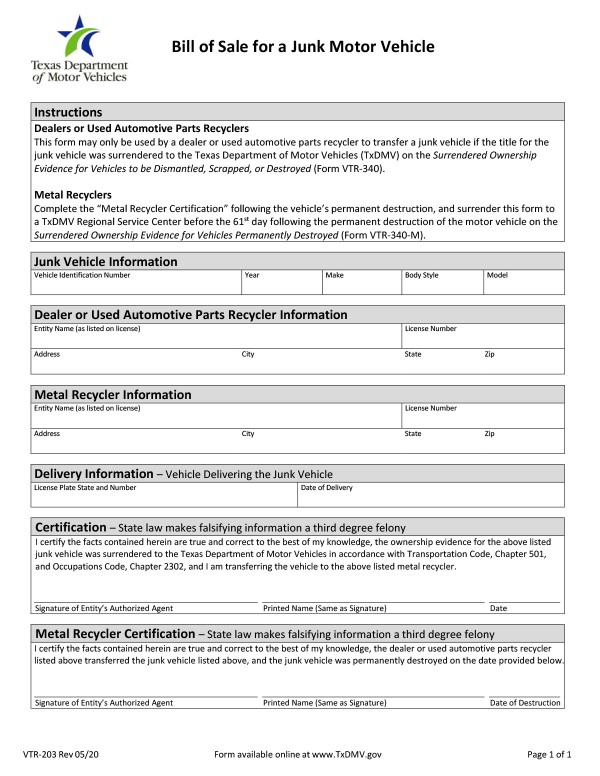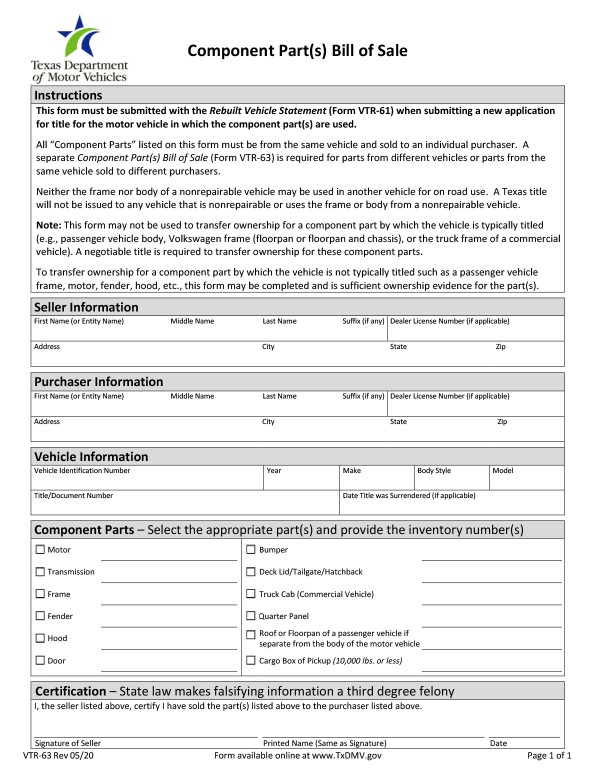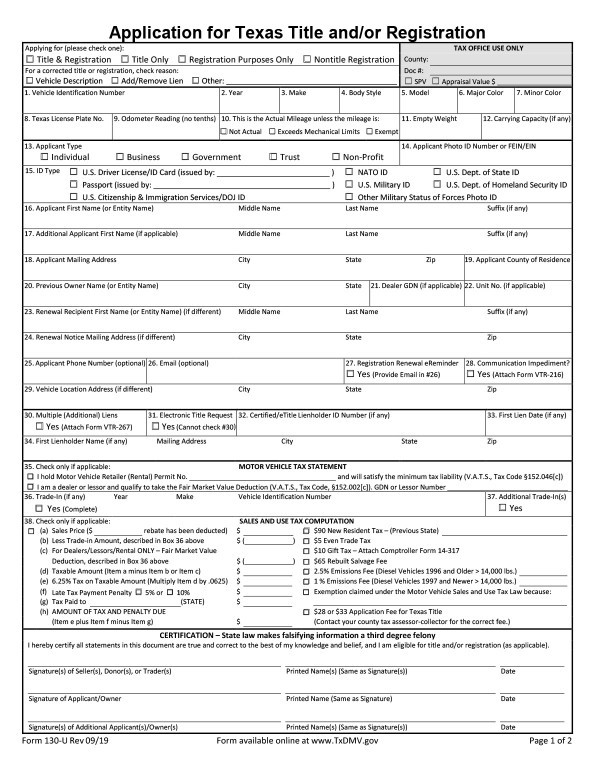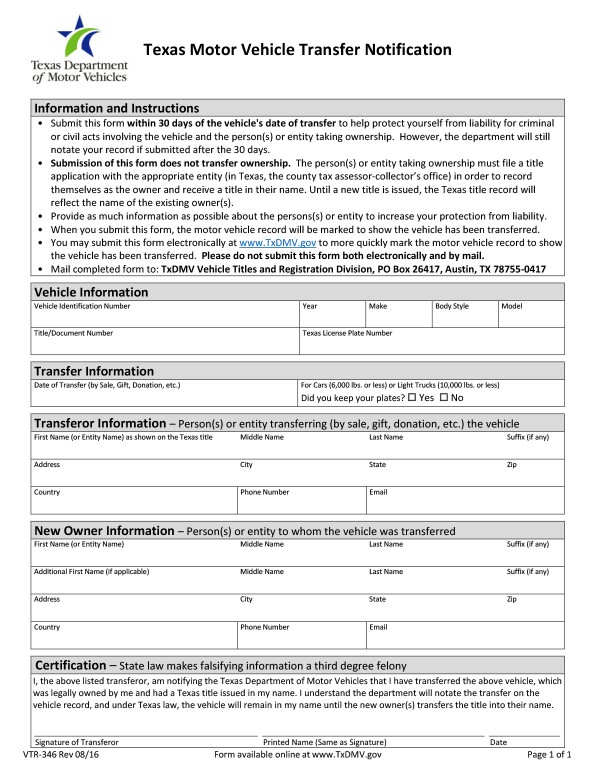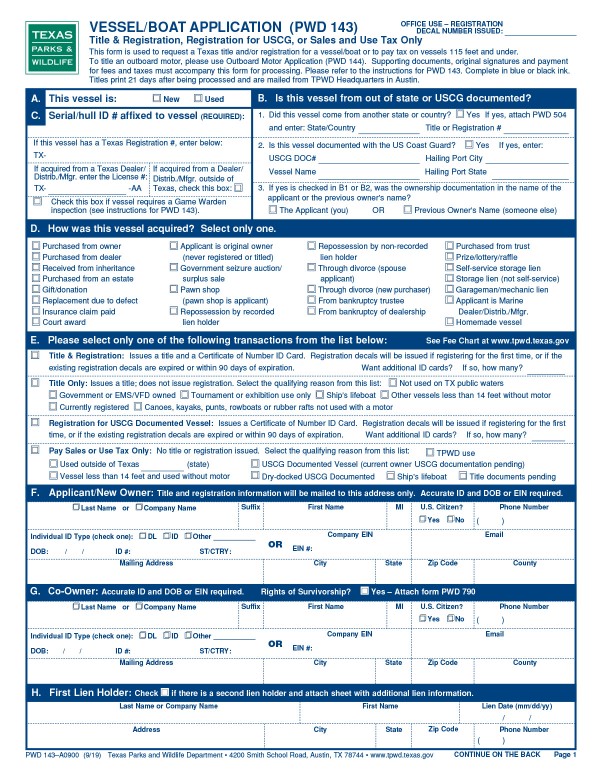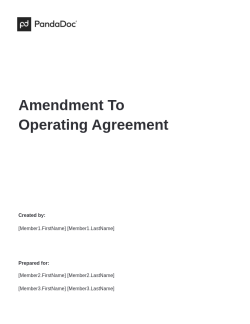Important Terms for a Bill of Sale
- Property location: This specifies the location of the item being sold, which can be especially important if the item is in a different state.
- Seller: This includes the seller’s information, such as name and address. This section can also list any additional sellers.
- Buyer: This specifies the buyer’s information. This section can list any additional buyers.
- Sales tax: This specifies whether sales tax will be included, how much it will be, and whether or not it is included in the price.
- Property: This section includes the date of the property transfer as well as any special conditions to the sale like “under warranty” or “as-is.” The VIN, plate number, and odometer reading for vehicles are listed here.
- Witness information: If a witness is present to sign the bill of sale, their full name, address and other contact information will be listed here. The witness can be either a public notary or a party agreed upon by the buyer and seller.
- As-is: This term means that the buyer is agreeing to purchase the item in its current state at the time of sale. By signing a bill of sale agreeing to purchase something as-is, the buyer is agreeing that they’ve had the opportunity to inspect the item and found it to their satisfaction.
- Gift: This identifies whether the item is being sold as a gift to the recipient, which will be important for tax purposes the following year.
- Trade-In: In the event one item is being traded for another, this section of the bill of sale will verify that the two items are equal in value.
- Certification/Signature: The signature of the seller and/or buyer, depending on the form, finalizes the transfer. In-person signatures are always valid. Digital signatures are valid if they are done through a certified digital signature provider. PandaDoc documents offer the option for legal digital signatures.
1. Texas Bill of Sale Requirements
The State of Texas requires that you complete a bill of sale if you buy or sell a car or boat within state boundaries. No other transactions require a bill of sale, but you may choose to complete one at your discretion.
Why Use One?
A bill of sale is like a receipt. If there is any dispute about whether the sale has happened or what exactly was sold, a bill of sale serves as evidence.
For example, say you bought a car and the seller decides to claim that you never paid them. You can present them with the bill of sale that includes the identification number of the vehicle, the date of sale, and the seller’s signature, officially nullifying their claim.
Additional Considerations
Language Requirements
The State of Texas allows you to write your own bill of sale in any language you choose, assuming that you include all of the information that would be included in the state template.
Number of Copies
You need three copies of the bill of sale in Texas:
- One for the buyer
- One for the seller
- One for the Department of Motor Vehicles (if you’re selling or buying a car) or the Texas Parks and Wildlife Department (if you’re selling or buying a boat)
If you’re completing a bill of sale for a transaction that doesn’t legally need one — for example, if you’re buying or selling a high-value item like a horse or firearm — you only need copies for the buyer and seller. However, you may choose to complete a third or fourth copy for the parties’ personal attorney(s).
Junk vehicles
Bills of sale can include a salvage or junked vehicle, provided the seller lists the vehicle as salvage or junk on the form.
After Purchasing a Vehicle
A bill of sale isn’t the only document you need to transfer ownership of a vehicle in Texas. You also need to obtain a title and registration before you can legally drive the vehicle.
If You’re the Seller…
You need to provide the buyer with your original title. Remember to add the date of sale and odometer reading before you hand the title over to the buyer. You also need to complete an Application for Texas Title and/or Registration and provide it to the buyer. Include:
- Your signature as the seller
- Your contact information
- Sales price
- Vehicle information
- Odometer reading
The buyer should fill in their personal information as “applicant” and sign on the correct line.
The rules are different if you’re selling to a dealership because then it stays in your name until the dealership sells it to someone else. In this case, your transfer notification or bill of sale serves as your proof that you have turned over ownership of the vehicle. That way, you’re not liable for accidents or violations by test drivers or dealership employees.
If You’re the Buyer…
You need to complete the remainder of the title application that the seller provides to you. Bring the completed application and your bill of sale to the Texas Department of Motor Vehicle within 30 days of the sale date. You will also need to bring:
- Proof of a completed Motor Vehicle Inspection
- Form VTR-40 for confirmation of odometer reading
- An Application for Registration Purposes Only (Form VTR-272) if there is a lien on the car
- Proof of insurance and driver’s license
- Sales tax of 6.2% on the assessed value or purchase price, whichever is more
- Title, registration, and local fees
You only have to visit your county tax office if you buy your car from a private party. If you buy from a dealership, the personnel there will complete your title paperwork for you.
2. Texas Car (Vehicle) Bill of Sale
Texas refers to its bill of sale documents as Vehicle Transfer Notifications. The official document is called a Form VTR-346, and it includes details about the car, sale, seller, and buyer, specifically:
- Vehicle Identification Number, or VIN
- Year, make, body style, and model of the vehicle
- Title number
- License plate number
- Date of transfer
- Whether the seller kept the plates
- Name and contact information for the seller (or transferor)
- Name and contact information for the buyer and any additional buyer(s)
- Signature of seller/transferor
The Texas Department of Motor Vehicles must receive the transfer notification by mail or electronically (but not both) within 30 days of sale.
3. Texas Boat Bill of Sale
The State of Texas requires that all boat sales include a bill of sale. There is no official state form, so it’s up to the seller and buyer to decide whether to use a downloaded Texas bill of sale form or submit a completed Form PWD 143, which is the title and registration application for a floating vessel.
The two-page application includes all of the relevant information that you need on a Texas bill of sale form for boats. These include:
- A detailed description of the vessel
- The vessel’s make, model, and serial number
- Sale date
- Sale price, excluding any trailer
- Buyer’s name(s)
- Seller’s name(s) and signature(s)
The Texas Parks and Wildlife Department must receive a completed bill of sale or Form PWD 143 within 20 days of the sale date. The buyer must also submit all sales tax and state fees, the amount of which depends on the vessel’s length. The seller must transfer the title to the buyer, and the buyer will receive a new title in the mail, assuming all documentation is received in time.
4. Texas Firearm Bill of Sale
Texas does not have laws governing firearms registration, so there is no legal requirement to file a bill of sale. Still, many gun buyers and sellers choose to complete bills of sale in order to avoid disputes about who owns the item.


